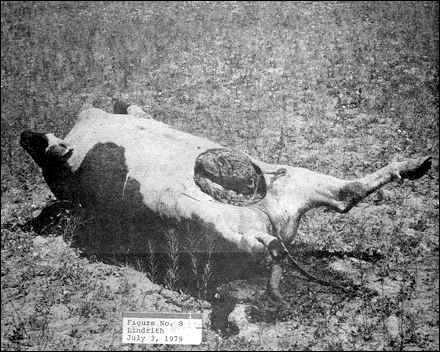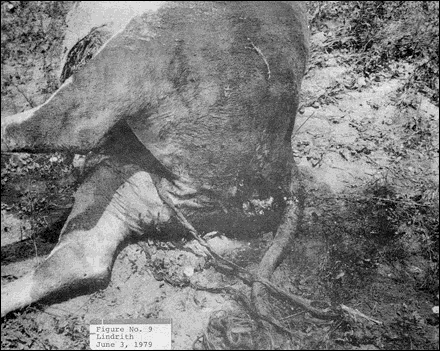The New Mexico State Police informed me that they had received a report of a livestock mutilation on July 3 in the Lindrith area. I learned that at approximately 10:45 a.m. on that date, a seven-year-old heifer weighing approximately 850 pounds, had been found dead by its owner.
The owner subsequently contacted the local livestock inspector and reported the incident as a mutilation. The owner stated he was not certain when the heifer died. However, he noted that about two days before the carcass was discovered, he had been through that area and had not seen the animal.
I conducted an on-the-scene investigation of this incident. The carcass was lying on its back with its head facing north -- the same position in which the animal had been discovered. Damage had been done to both the udder area and the anus region, which contained a hole approximately four inches in diameter. The eyes, lips, and tongue, however, were intact.
There was abundant evidence of scavenger activity. Not only was bird defecation evident on the carcass, but also the owner told me that when he first found the animal, he noticed ravens nearby. He immediately left the area to inform his wife of the animal's death. When he returned to the carcass, he saw a coyote, which he shot and killed.
A livestock inspector also arrived at the scene and concluded that the damage to the carcass was totally consistent with scavenger activity. However, he did comment that he had never seen a cow die lying flat on its back. Although that position may not be common, it should be noted that there are no set rules or findings concerning the position in which an animal must die. Moreover, veterinarians have advised me that when an animal begins to bloat after its death, the carcass has a tendency to turn toward the back. Cattle dying from anthrax also have a tendency to die with their feet straight in the air, according to Dr. Robert Pyles, veterinarian for the New Mexico Livestock Board. Dr. Pyles did point out, though, that anthrax had not recently been observed in New Mexico. A few weeks later, however -- on July 27 to be exact -- an anthrax epidemic was reported in Union and Colfax Counties.

Figure No. 8 shows the position in which the animal was found. Bird defecation is apparent on the carcass.
Moreover, one can see by the way the entrails are hanging out of the open body cavity that scavengers are a much more likely culprit than "highly skilled surgeons." The stain on the ground near the rear of the carcass has been made by fluids draining out of the body.

Figure No. 9, which was taken after the carcass was rolled over, clearly shows the entrails hanging out of the body cavity as well as the rough and torn damage sustained in the anus region. Again, the body fluids from the carcass are very noticeable. lead this carcass been discovered several days later, the stained area would either have evaporated or been licked clean by scavengers, as was the case in the Coyote incident. It is easy to understand why carcasses found in such a condition are often reported as being "devoid of blood."
In conclusion, the facts presented in the preceding discussion all lead to one verdict -- that the carcass was mutilated by scavengers. Not only were birds and coyotes at the scene, but the damage done to the carcass was obviously rough. As in keeping with the objectives set out earlier, I have not tried to determine the cause of the animals death. However, I think the possibility of a lightning kill, which is quite prevalent among livestock, should be considered in this incident.